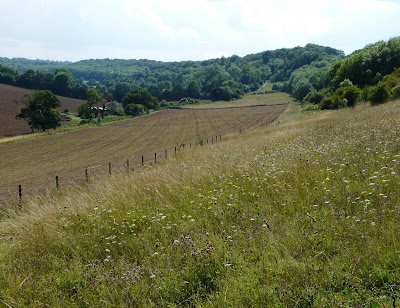 High Elms Country Park is a mile or so from Down House, the 'good, very ugly' home of Charles Darwin. A latterday Darwin, Fred Greenie, has studied closely the park and particularly Cuckoo Wood, as reported in his excellent blog, Greenie in the Wild.
High Elms Country Park is a mile or so from Down House, the 'good, very ugly' home of Charles Darwin. A latterday Darwin, Fred Greenie, has studied closely the park and particularly Cuckoo Wood, as reported in his excellent blog, Greenie in the Wild. Fred kindly lent me an afternoon of his skills, knowledge and patience to show me around the park. He also pointed out the musk orchid bank, where much of Darwin's time was spent in work and contemplation, and where Irene Palmer continues his studies, illustrated on a slide-show here.
Fred kindly lent me an afternoon of his skills, knowledge and patience to show me around the park. He also pointed out the musk orchid bank, where much of Darwin's time was spent in work and contemplation, and where Irene Palmer continues his studies, illustrated on a slide-show here. One of the targets for our walk was views of egg-laying by silver-washed fritillaries, and when the sun came out, so did they, in good numbers. These large butterflies performed well, with the females being chased by males, the floppy flight of the former being accompanied by cork-screwing attendance of the latter.
One of the targets for our walk was views of egg-laying by silver-washed fritillaries, and when the sun came out, so did they, in good numbers. These large butterflies performed well, with the females being chased by males, the floppy flight of the former being accompanied by cork-screwing attendance of the latter. In a glade, just where Fred predicted, a female was seen laying eggs on a tree trunk, then flying up to a sunny branch for a rest before returning to continue her task.
In a glade, just where Fred predicted, a female was seen laying eggs on a tree trunk, then flying up to a sunny branch for a rest before returning to continue her task.She seeks out craggy, gnarled bark with moist dark crevices.... so naturally sought out Fred's clothing.

 Later, she showed that there was no favouritism and landed on my corduroy trousers.
Later, she showed that there was no favouritism and landed on my corduroy trousers. The clearings had a good mixture of low chalkland plants like marjoram and taller scrub including plenty of heady flowering hemp agrimony that attracted butterflies, moths and other bugs. While waiting for the arrival of a white-letter hairstreak (it didn't) we watched a hornet blundering its way around the flowers, hunting prey, which it eventually found, caught and consumed.
The clearings had a good mixture of low chalkland plants like marjoram and taller scrub including plenty of heady flowering hemp agrimony that attracted butterflies, moths and other bugs. While waiting for the arrival of a white-letter hairstreak (it didn't) we watched a hornet blundering its way around the flowers, hunting prey, which it eventually found, caught and consumed.
 It's good to visit places outside one's usual area, and I had to ask the name of this plant - a white mullein - which is frequent in the west of kent but unknown in the east.
It's good to visit places outside one's usual area, and I had to ask the name of this plant - a white mullein - which is frequent in the west of kent but unknown in the east.Some stars pointed out included three helleborines:



3 comments:
A well spent afternoon with the 'green one' steve. Ive never seen any kind of Fritalaria, (is that a word?)
A Helleborine-of-a-good day in the field, Steve.
Hemp Agrimony always reminds me of Pink Lamingtons - a quick google/ images will resolve any mystery.
Steve ,
You might want to re-write this post after mine of Saturday .
I think Rob's 'Pink Lamingtons' must be an island thing .
Post a Comment